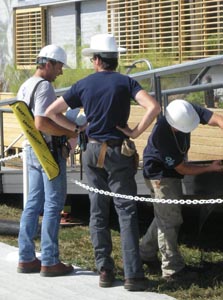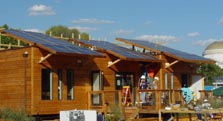Daily Journal - October 10, 2007
Click photo to view a larger image.


Tom Meyers, a Solar Decathlon inspector, consults with members of the University of Texas at Austin team.

The University of Illinois house is constructed by combining three fully self-contained modules. The design enables the house to be easily expandable as a family's needs change.

Many of the houses are using sustainable vegetation, such as the University of Illinois team's use of native Illinois plants and prairie grasses. Late last night they were trucking in more than 300 plants to give a beautiful green finishing touch to their very "green" house.
Solar Decathlon 2007
Day Eight: Meeting and Advancing Building Codes
Today is the last full day of work. The teams are down to the wire to complete assembly and pass inspection. Despite all of the tremendous hard work of the last two years, the teams can't compete until the houses are safe and fully inspected.
One of the Decathlon's lead inspectors, Tom Meyers, can attest to the current frantic pace for many of the teams. He and his crew are running at full speed today as the teams are clamoring for their attention. Tom and the other inspectors are called to go beyond their usual building code work because of the many new and innovative approaches these teams are taking in their solar-powered homes. Each Solar Decathlon brings to light many innovative materials and systems that the existing U.S. building codes haven't even contemplated yet.
The challenge is to keep building codes current with the changing technologies so the great advantages of solar power can be fully realized. Tom and many others here at the Decathlon are helping with that as they take knowledge of these new technologies from here right to the building industry. Tom is especially helpful in this regard, in his pre- and post-Decathlon life as a building code consultant.
One interesting example of progress in the final stretch is the University of Illinois team. Their reliance on a design consisting of modular cubes allowed early assembly of their primary structure. The modules needed no cranes or heavy forklift, but were assembled by the team itself. This gave some advantages in the later stages, like now, as they can focus on the finishing details that will please the many visitors on opening day.


